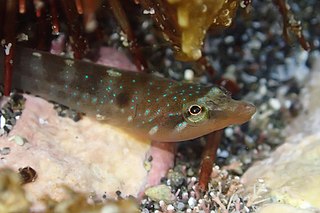
The New Zealand urchin clingfish is a clingfish. It is found around New Zealand wherever sea urchins are present. Its length is between 2 and 3 cm.
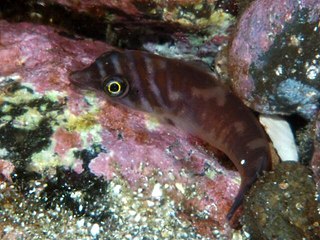
Clingfishes are fishes of the family Gobiesocidae, the only family in the order Gobiesociformes. These fairly small to very small fishes are widespread in tropical and temperate regions, mostly near the coast, but a few species in deeper seas or fresh water. Most species shelter in shallow reefs or seagrass beds, clinging to rocks, algae and seagrass leaves with their sucking disc, a structure on their chest.

Dellichthys is a small genus of clingfishes from the family Gobiesocidae which are endemic to New Zealand. It had been regarded as a monotypic genus but a second species was described in 2018.
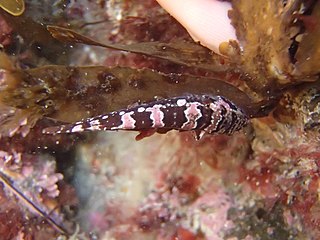
Hector's clingfish is a clingfish of the family Gobiesocidae, the only species in the genus Gastrocyathus. It is found all down the east coast of New Zealand around the low water mark amongst seaweed, on rocky coastlines. Its length is up to 6.4 centimetres (2.5 in) SL. This species was described in 1876 by Albert Günther as Crepidogaster hectoris from a holotype collected on the south shore of the Cook Strait. Günther honoured the Scottish-born scientist James Hector (1834-1907) who was the Director of the Geological Survey of New Zealand and who presented type to the British Museum.

Small red scorpionfish is a venomous Scorpionfish, common in marine subtropical waters. It is widespread in the Eastern Atlantic from the Bay of Biscay to Senegal, Madeira, Azores and the Canary Islands, including the Mediterranean and the Black Sea.

Apletodon is a genus of marine fish in the family Gobiesocidae (clingfishes). The genus was first named by John Carmon Briggs in 1955.

Diplecogaster is a genus of fish in the family Gobiesocidae found in Black Sea, Mediterranean Sea and Atlantic Ocean.

Kopua is a genus of clingfishes found in the Pacific Ocean.
Mendeleev's clingfish is a species of fish in the family Gobiesocidae endemic to Madang Province in Papua New Guinea. This species is the only known member of its genus. This species was described in 2005 by Artem Mikhailovich Prokofiev, the type being collected near the village of Bongu in Madang Province from the research vessel Dmitrii Mendeleev, referred to in its specific name. The vessel was in turn named in hours of the Russian chemist Dmitrii Mendeleev (1834-1907), the creator of the most widely recognised periodic table.
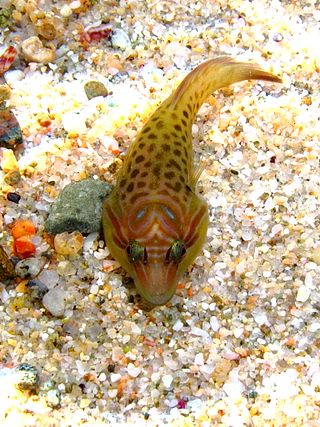
Lepadogaster is a genus of clingfishes native to the eastern Atlantic Ocean extending into the Mediterranean Sea. Lepadogaster belongs to class Actinopterygii. This means that they share many of the same characteristics as eels, ray-finned fish, and sea horses to name a few. The main characteristic of all of them though is having fin rays. These fin rays are made of webbed skin and are attached to portions of the body that connect fins to the bones. Lepadogaster species have a distinct difference in the formation of their dorsal and anal fins. While most other ray-finned fish spines, branched fin-rays, and middle radials, Lepadogaster species do not have these. Instead, they have cartilage in place of the mentioned features. These clingfish are mainly found near the rocky coasts and inside intertidal zones. Lepadogaster is known mostly as a clingfish, meaning that it spends most of its time attached to the surface of rocks.
Owstonia taeniosoma is a species of marine ray-finned fish belonging to the family Cepolidae, the bandfishes. It is known from the Indo-West Pacific region.

Lepadogaster candolii, common name Connemarra clingfish, is a species of fish in the genus Lepadogaster. It occurs in the Eastern Atlantic from the British Isles south to Madeira and the Canary Islands and into the western Mediterranean and the Black Sea. The specific name candolii honours the Swiss botanist Augustin Pyramus de Candolle (1778-1841) and has various spellings: candolii, candolei, candollei, and decandollii, but only the first one is correct. Some workers have found that L. candolii is not closely related to the other two species in the genus Lepadogaster and have proposed the placing of this species in the revived monotypic genus Mirbelia Canestrini, 1864, at least until more definitive taxonomic studies can be undertaken.

Lepadogaster purpurea, the Cornish sucker, is a species of clingfish from the family Gobiesocidae. It is found in the eastern North Atlantic Ocean and in the western Mediterranean Sea.
The São Tomé clingfish is a species of marine fish of the family Gobiesocidae (clingfish). It grows to 1.4 cm maximal length. It occurs in the eastern Atlantic Ocean, around the islands of São Tomé and Príncipe between 0 and 3 metres depth. The species was first described in 2007 by Ronald Fricke, its specific name honouring the collector of the type, marine biologist Peter Wirtz of Madeira.

Diplecogaster bimaculata, the two-spotted clingfish, is a species of fish in the family Gobiesocidae found in Black Sea, Mediterranean Sea and Atlantic Ocean where it is found on rocks and among seagrass or shell beds.

Lepadichthys frenatus, the bridled clingfish, is a species of clingfish from the family Gobiesocidae. It is found on shallow reefs in the western Pacific Ocean.

Opeatogenys gracilis is a species of clingfish from the family Gobiesocidae which is found in the Mediterranean Sea and in the eastern Atlantic Ocean. Suggested common names for this species are the pygmy clingfish and the seagrass clingfish.
Opeatogenys cadenati is a species of clingfish from the family Gobiesocidae. It occurs in the eastern Atlantic and has been recorded off Ghana, Senegal and Morocco, as well as off the Canary Islands. This species was described by John C. Briggs in 1957 with a type locality of Chenal de Joal off Senegal. Briggs honoured the French ichthyologist Jean Cadenat (1908-1992) who was Director of the Marine Biological Section of the Institut Français d’Afrique Noire in Gorée, Senegal.
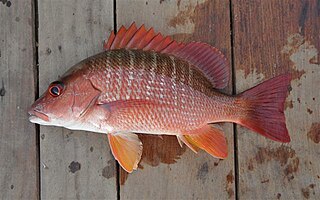
The Gorean snapper is a species of marine ray-finned fish, a snapper belonging to the family Lutjanidae. It is found in the eastern Atlantic Ocean.
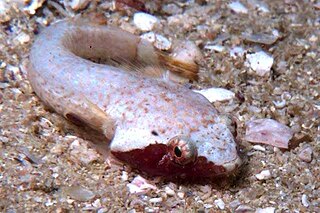
Apletodon pellegrini, the chubby clingfish, is a species of clingfish of the family Gobiesocidae. The species is found in the Eastern Atlantic, from Madeira, Cape Verde, Canary Islands, Annobon Islands, mainland shore from Cape Blanco south to Port Alfred, South Africa.













